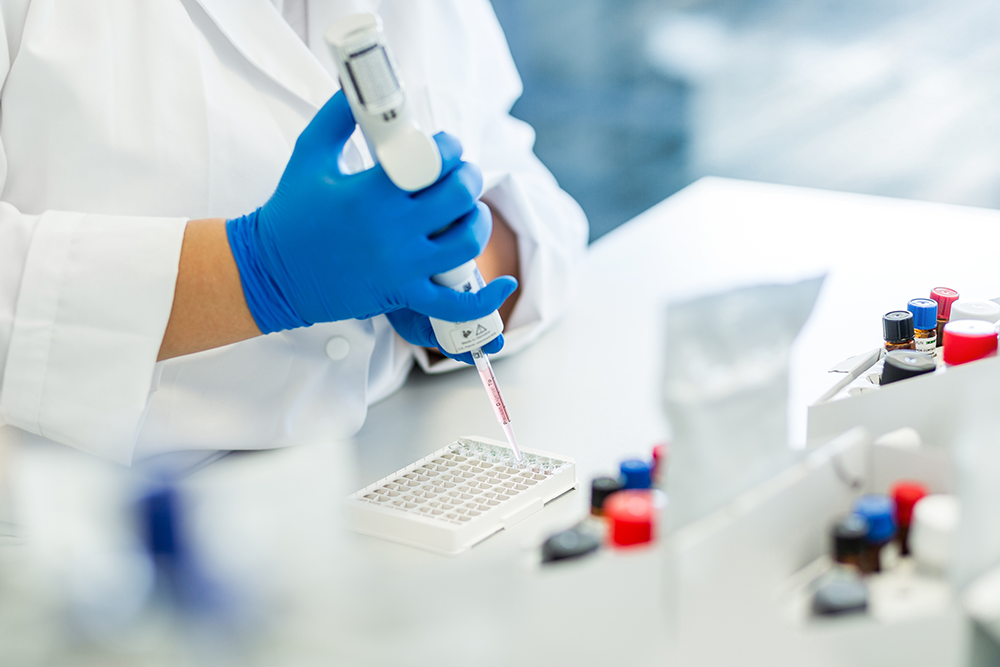Tests
Teste serologice
SeraSpot, ELISA, IFT, Immunoblot și immunoarray sunt metode serologice pentru diagnosticarea bolilor infecțioase. Ele identifică anticorpii sau antigenii.

Metode serologice
În laboratorul nostru, testăm anticorpi specifici pentru diverse infecții utilizând metodele SeraSpot, IFT și ELISA. În general, SeraSpot are o specificitate și sensibilitate comparativ mai ridicate decât tehnicile IFT și ELISA. Totuși, formarea de anticorpi specifici împotriva Borrelia burgdorferi poate fi inhibată sau suprresată de terapia cu antibiotice. Astfel de cazuri pot fi adesea diagnosticate folosind EliSpot.
SeraSpot
SeraSpot MicroArray pentru determinarea anticorpilor împotriva Borrelia burgdorferi combină tehnica ELISA standardizată și stabilită cu analiza microarray. Antigenele extrem de specifice ale Borrelia burgdorferi sunt aplicate sub formă de pete pe fundul puțurilor dintr-o placă de microtitrare, la scară nanoliter. Controalele sunt integrate în fiecare puț.
ELISA
ELISA este o metodă serologică utilizată pentru detectarea anticorpilor în probe biologice. În această procedură, antigenii sunt imobilizați pe un suport solid, cum ar fi fundul unei plăci de microtitrare. Proba care conține anticorpii de testat este apoi adăugată pe suport. Dacă anticorpii specifici sunt prezenți în probă, aceștia se leagă de antigenii imobilizați. După spălarea substanțelor nelegate, se adaugă un anticorp secundar legat de enzime, care se leagă de anticorpii primari. Adăugarea unui substrat pentru enzimă produce un semnal măsurabil, oferind informații despre prezența și cantitatea de anticorpi specifici din probă.
IFT – Test de imunofluorescență
Testul de imunofluorescență este o altă metodă serologică utilizată frecvent pentru identificarea anticorpilor împotriva antigenilor specifici. În această procedură, antigenii sunt aplicați pe un suport solid, similar cu ELISA. Proba este apoi adăugată pe suport și, dacă anticorpii specifici sunt prezenți, aceștia se leagă de antigeni. Ulterior, se adaugă un anticorp secundar marcat fluorescent, care se leagă de anticorpii primari. La excitația cu lumină de anumite lungimi de undă, anticorpii marcați fluorescent emit lumină, care poate fi vizualizată cu un microscop de fluorescență. Prezența fluorescentului indică prezența anticorpilor specifici în probă.
Immunoblot
Immunoblot, cunoscut și sub numele de Western blot, este o metodă avansată pentru identificarea proteinelor în probe biologice. În cazul infecțiilor, această metodă este adesea utilizată pentru a confirma prezența anticorpilor specifici împotriva anumitor proteine sau antigene. În primul rând, proteinele sunt separate prin electroforeză în funcție de dimensiunea lor și apoi transferate pe un suport solid, cum ar fi un membrană de nitroceluloză. Proba este apoi aplicată pe suport și, dacă anticorpii specifici sunt prezenți, aceștia se leagă de proteinele corespunzătoare. Ulterior, anticorpii legați sunt vizualizați, adesea prin adăugarea unui anticorp secundar legat de enzime sau fluorescență și a unui substrat adecvat. Modelele de benzi generate de immunoblot pot oferi informații despre prezența și specificitatea anticorpilor din probă.
Immunoarray
Immunoarray, cunoscut și sub numele de microarray, este o metodă serologică avansată pentru detectarea anticorpilor în probe biologice. Similar cu SeraSpot MicroArray, Immunoarray permite analiza simultană a unei varietăți de anticorpi împotriva antigenilor specifici. Utilizând cantități de probă de nanoliter, antigenii pot fi imobilizați pe microarray-uri, permițând o analiză precisă și extrem de sensibilă. Această tehnologie oferă o caracterizare eficientă și cuprinzătoare a răspunsului imunitar al pacientului la infecții precum boala Lyme și contribuie la o diagnosticare și tratament mai precise.
Provocări în diagnosticul serologic al bolii Lyme:
Infecțiile cu borrelioză nu pot fi complet excluse pe baza rezultatelor negative ale testelor serologice. Laboratoarele ar trebui să investigheze "VIsE" (acronim pentru: Variable major protein-like sequence Expressed) în sistemele de testare ELISA și SeraSpot. VIsE descrie capacitatea „cameleonului” Borrelia burgdorferi de a-și schimba permanent structura proteică VIsE în vivo pentru a preveni detectarea de către sistemul imunitar. Atunci când se caută anticorpi împotriva Borrelia burgdorferi, VIsE are cea mai mare sensibilitate.
Rezultatele studiilor și comparațiile testelor
- „În cazul ELISA, rezultate pozitive sau borderline au fost observate doar la 24 de pacienți (53,3%).“ (Wojciechowska-Koszko et al., feb. 2011)
- „32 de pacienți au avut anticorpi specifici anti-borrelia confirmați prin utilizarea western blot, în ciuda ELISA-ului negativ… În cazurile cu dificultăți persistente, este necesar să se utilizeze testul western blot… Probabil că aceasta se datorează producției foarte scăzute de anticorpi specifici, cauzată și de starea de imunodeficiență detectată la toți pacienții noștri.“ (Durovska et al., 2010)
- „Numărul de rezultate pozitive la ELISA pentru IgM și/sau IgG… a variat de la 34 la 59%... Compararea immunoblots a arătat diferențe mari în acordul între teste… Remarcabil, unele immunoblots au dat rezultate pozitive în probe care fuseseră testate negativ de toate cele opt ELISA-uri.“ (Ang CW et al., ian. 2011)
SeraSpot MicroArray analizează următorii anticorpi IgG și IgM ai Borrelia burgdorferi și subspecii de Borrelia burgdorferi cu specificitate mare:
VlsE (Borrelia burgdorferi afzelii), p39 (B.b. afzelii), p58 (B.b. garinii), p100 (B.b. afzelii), OspC (B.b. afzelii + B.b. garinii + B.b. sensu stricto), DbpA (B.b. afzelii + B.b. garinii + B.b. sensu stricto).
